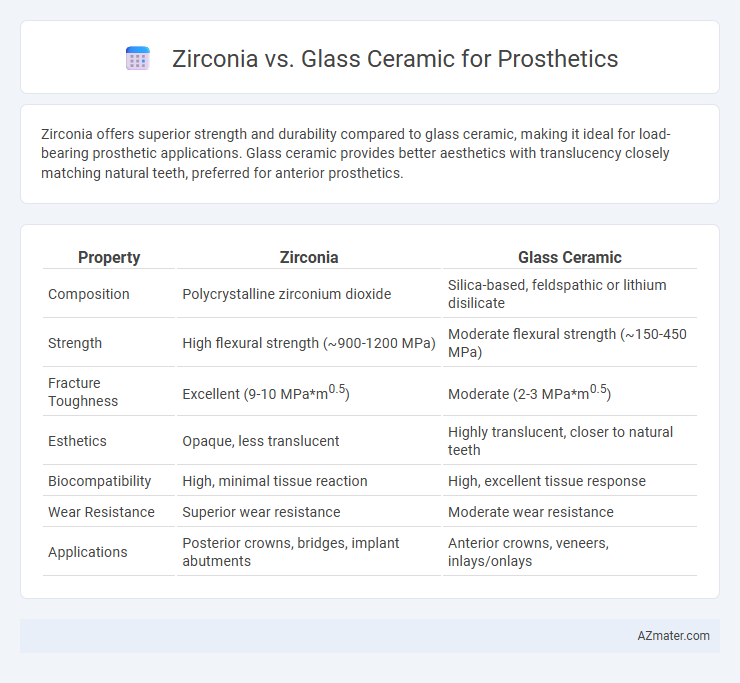Zirconia offers superior strength and durability compared to glass ceramic, making it ideal for load-bearing prosthetic applications. Glass ceramic provides better aesthetics with translucency closely matching natural teeth, preferred for anterior prosthetics.
Table of Comparison
| Property | Zirconia | Glass Ceramic |
|---|---|---|
| Composition | Polycrystalline zirconium dioxide | Silica-based, feldspathic or lithium disilicate |
| Strength | High flexural strength (~900-1200 MPa) | Moderate flexural strength (~150-450 MPa) |
| Fracture Toughness | Excellent (9-10 MPa*m0.5) | Moderate (2-3 MPa*m0.5) |
| Esthetics | Opaque, less translucent | Highly translucent, closer to natural teeth |
| Biocompatibility | High, minimal tissue reaction | High, excellent tissue response |
| Wear Resistance | Superior wear resistance | Moderate wear resistance |
| Applications | Posterior crowns, bridges, implant abutments | Anterior crowns, veneers, inlays/onlays |
Introduction to Dental Prosthetic Materials
Zirconia and glass ceramic are two prominent dental prosthetic materials valued for their durability and aesthetics. Zirconia offers exceptional strength and fracture resistance, making it suitable for high-stress restorations such as crowns and bridges. In contrast, glass ceramics provide superior translucency and esthetic appeal, ideal for anterior prosthetics requiring natural tooth-like appearance.
Overview of Zirconia in Prosthetics
Zirconia is a highly durable and biocompatible material frequently used in prosthetic dentistry due to its superior strength and fracture resistance compared to glass ceramics. Its opacity and ability to withstand high masticatory forces make it ideal for posterior crowns and bridges, where functional demands are greatest. The material's excellent esthetic properties combined with low plaque affinity contribute to its growing popularity in both anterior and posterior prosthetic restorations.
Glass Ceramic: Properties and Applications
Glass ceramic prosthetics offer superior esthetic qualities due to their translucency and color matching capabilities, closely mimicking natural tooth enamel. These materials exhibit excellent biocompatibility and low thermal conductivity, reducing sensitivity and enhancing patient comfort. Widely used in veneers, inlays, and onlays, glass ceramics provide durable, minimally invasive restorative options with strong resistance to wear and fracture.
Mechanical Strength: Zirconia vs Glass Ceramic
Zirconia demonstrates superior mechanical strength compared to glass ceramics, making it highly resistant to fracture and chipping in prosthetic applications. With a flexural strength typically ranging from 900 to 1200 MPa, zirconia outperforms glass ceramics, which usually have strengths between 100 and 300 MPa. This difference in mechanical properties makes zirconia a preferred material for load-bearing dental prosthetics requiring enhanced durability and longevity.
Esthetic Outcomes in Prosthetic Restorations
Zirconia offers superior strength and translucency, making it ideal for durable prosthetic restorations with natural esthetic outcomes. Glass ceramics provide exceptional color matching and translucency, closely mimicking natural tooth enamel for highly esthetic restorations in anterior regions. Both materials enhance prosthetic esthetics, but glass ceramics excel in lifelike appearance, while zirconia ensures long-term structural integrity.
Longevity and Durability
Zirconia offers superior longevity and durability compared to glass ceramic in prosthetic applications due to its high fracture toughness and resistance to wear and chipping. Glass ceramic prosthetics, while more esthetic with translucency similar to natural teeth, tend to have lower strength and are more prone to fractures under heavy occlusal forces. Clinical studies indicate that zirconia crowns and bridges can last over 10 years with minimal degradation, making them ideal for long-term prosthetic solutions.
Biocompatibility and Patient Safety
Zirconia offers superior biocompatibility in prosthetic applications due to its excellent tissue integration and low risk of allergic reactions, making it safer for patients with metal sensitivities. Glass ceramic, while aesthetically pleasing and compatible with oral tissues, generally exhibits higher brittleness and potential for microcracks that may compromise long-term safety. The durable, inert nature of zirconia ensures enhanced patient safety by minimizing inflammatory responses and mechanical failure in prosthetic restorations.
Clinical Indications and Case Selection
Zirconia offers superior strength and fracture resistance, making it ideal for posterior crowns and bridges in high-load situations, while glass ceramics provide excellent aesthetics suited for anterior restorations with minimal occlusal stress. In clinical indications, zirconia is preferred for full-contour prosthetics requiring durability, whereas glass ceramics excel in cases demanding translucency and natural tooth appearance. Careful case selection involves assessing occlusal forces, esthetic requirements, and preparation design to determine the most appropriate material for long-term success.
Cost-Effectiveness and Accessibility
Zirconia prosthetics offer superior durability and strength compared to glass ceramics, often resulting in longer-lasting restorations that reduce the need for replacements, enhancing cost-effectiveness despite a higher initial price. Glass ceramic prosthetics tend to be more affordable upfront and are widely accessible due to simpler fabrication processes, making them suitable for patients with budget constraints or limited access to advanced dental labs. The choice between zirconia and glass ceramic ultimately depends on balancing upfront costs with long-term benefits and availability within specific healthcare settings.
Conclusion: Choosing the Right Material
Zirconia offers superior strength and durability, making it ideal for posterior prosthetics that require high load resistance, while glass ceramic provides excellent esthetics and translucency suited for anterior restorations. Glass ceramic's fracture toughness is lower, so it is preferable in low-stress areas where natural appearance is the priority. Selecting the right material depends on balancing mechanical requirements with esthetic demands for optimal prosthetic outcomes.

Infographic: Zirconia vs Glass ceramic for Prosthetic
 azmater.com
azmater.com